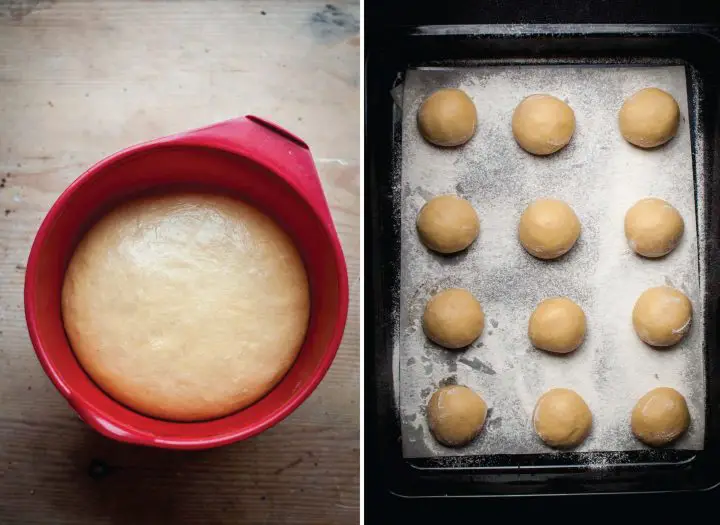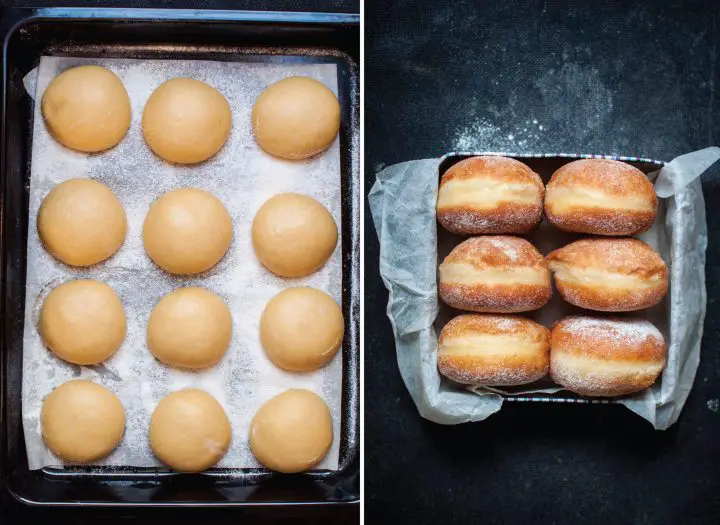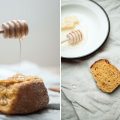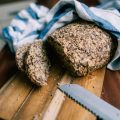Whether you call them sourdough doughnuts, Berliners, bomboloni, paczki or something different – wait no more, the recipe awaits – worth every minute, I promise.

Table of Contents
- The Softest Sourdough Doughnuts
- Ingredients for these Sourdough Doughnuts
- How to Bake Sourdough Doughnuts
- FAQs

Sourdough Doughnuts with Strawberry and Apple Pie Cream
- Total Time: 23 hrs 32 mins
- Yield: 15 doughnuts 1x
Ingredients
Starter
- 90 g white wheat flour (bread flour)
- 20 g powdered brown sugar
- 25 g active sourdough starter
- 40 g water
Dough
- 500 g white wheat flour (bread flour, 100%)
- all of the above starter (appr. 175g)
- 3 eggs (appr. 165 g)
- 60 g brown sugar (12%)
- 10 g rum (appr. 1 tbsp) (2%)
- 10 g salt (2%)
- 110 g milk or water (22%)
- pinch of vanilla
- lemon zest of one lemon
- 120 g softened butter (24%)
- oil for frying
- sugar for coating
Filling
- strawberry crème légère
- apple pie cream
Instructions
- In the morning, prepare your sourdough starter. The starter will be stiff, more like a dough. Leave it to ferment until risen, puffed, and active. This may take from 4-12 hours, depending on the temperature and strength of your starter.
- In the evening/late afternoon, mix the dough. First, dissolve your entire starter in 110 g of milk. Add all other ingredients, except for the butter. Mix everything together. If the dough feels dry, don’t be tempted to add too much of additional liquid – mixing in the butter in the following phase will soften the dough (experiment with the softness of the dough) – but do add the liquid if the dough is too stiff. Knead the dough for 5-6 minutes and then leave it to rest for 15-20 minutes.
- Next, knead in half of the butter quantity. Once completely integrated, add and knead in the other half. Knead the dough for 8-10 minutes (it is advisable to use mixer) until smooth. Shape the dough into ball and place it into clean bowl. Cover with plastic wrap and leave to ferment at the room temperature for 3-4 hours until the volume increases by half of the initial state, then put the bowl into the fridge overnight.
- In the morning, take the dough out of the fridge and divide it into 15 pieces, each weighing 70 g. Shape each piece into a ball and place it on slightly floured tray lined with parchement paper. Cover the tray with clingfilm – this will prevent the dough from drying out. Leave the balls to rise until passing the poking test (appr. doubled in volume) – make an indent – if the indent comes back quickly, leave them to ferment a little bit more. Final rise may take 4-7 hours, it’s temperature depending.
- When the balls are risen enough, prepare the frying oil. Heat to 175-180°C/347-356°F. If the oil isn’t hot enough, the doughnuts will soak the oil and be greasy. If the oil is too hot, the doughnuts will cook very fast on the outside, but will be unbaked inside, so make sure it’s at the right temperature. It is advisable to sacrifice one doughnut to see how it bakes. Also, keep in mind that at the end of frying the oil becomes hotter.
- Fry each doughnut for 2-3 minutes on one side (or until nicely brown) and 2 minutes on another side. When fried, transfer them onto a plate lined with a napkin, so they soak up the excessive fat.
- Dust the doughnuts with powdered sugar (or roll them into sugar), then leave them to cool down before filling them.
- To fill the doughnuts, make a short incision with the knife, then use a pastry bag to fill them with the filling of your choice.
Notes
- The dough for these sourdough doughnuts was mixed in the afternoon, left to rise for 3-4 hours at room temperature to increase the volume, put in the fridge overnight, shaped in the morning, left to rise and fried in the afternoon of that day.
- Baker’s percentages are put in brackets if you would like to scale up or down the formula.
- Please feel free to add more liquid (20-50 g) more, if you feel the dough is too stiff and your flour can absorb more liquid. The dough should be soft, not runny but also not too stiff.
- Prep Time: 23 hrs 26 mins
- Cook Time: 6 mins
- Category: dessert
The Softest Sourdough Doughnuts
Yields: 15 doughnuts
The dough for these sourdough doughnuts was mixed in the afternoon, left to rise for 3-4 hours at room temperature to increase the volume, put in the fridge overnight, shaped in the morning, left to rise and fried in the afternoon of that day.
Ingredients for these Sourdough Doughnuts
Note: Baker’s percentages are put in brackets if you would like to scale up or down the formula.
Starter
- 90 g white wheat flour (bread flour)
- 20 g powdered brown sugar
- 25 g active sourdough starter
- 40 g water
Dough
- 500 g white wheat flour (bread flour) (100%)
- all of the above starter (appr. 175g)
- 3 eggs (appr. 165 g)
- 60 g brown sugar (12%)
- 10 g rum (appr. 1 tbsp) (2%)
- 10 g salt (2%)
- 110 g milk or water (22%) – I used milk**
- pinch of vanilla
- lemon zest of one lemon
- 120 g softened butter (24%)
**Please feel free to add more liquid (20-50 g) more, if you feel the dough is too stiff and your flour can absorb more liquid. The dough should be soft, not runny but also not too stiff.
- oil for frying
- sugar for coating
Filling
- strawberry crème légère – I used this recipe
- or apple pie cream (for this, I first cut apples into small pieces and sauteed them on the butter until soft. I then added cinnamon, vanilla powder, brown sugar and little bit of lemon juice. Next, I blended everything in a blender and let the batter cool down completely in the fridge. When cooled I mixed it into the whipped cream and seasoned to taste with additional cinnamon and vanilla powder)
How to Bake Sourdough Doughnuts
Sourdough Starter
- In the morning, prepare your sourdough starter. The sourdough starter will be stiff, more like a dough. Leave it to ferment until risen, puffed, and active. This may take from 4-12 hours, depending on the temperature and strength of your starter.
Dough
- In the evening/late afternoon mix the dough. First, dissolve your entire sourdough starter in 110 g of milk. Add all other ingredients, except for the butter. Mix everything together. If the dough feels dry, don’t be tempted to add too much of additional liquid – mixing in the butter in the following phase will soften the dough (experiment with the softness of the dough) – but do add the liquid if the dough is too stiff. Knead the dough for 5-6 minutes and then leave it to rest for 15-20 minutes.
- Next, knead in half of the butter quantity. Once completely integrated, add and knead in the other half. Knead the donut dough for 8-10 minutes (it is advisable to use mixer) until smooth. Shape the dough into ball and place it into clean bowl. Cover with plastic wrap and leave to ferment at the room temperature for 3-4 hours until the volume increases by half of the initial state, then put the bowl into the fridge overnight.
- In the morning, take the dough out of the fridge and divide it into 15 pieces, each weighing 70 g. Shape each piece into a ball and place it on slightly floured tray lined with parchment paper. Cover the tray with clingfilm – this will prevent the dough from drying out. Leave the balls to rise until passing the poking test (appr. doubled in volume) – make an indent – if the indent comes back quickly, leave them to ferment a little bit more. Final rise may take 4-7 hours, it’s temperature depending.

- When the balls are risen enough, prepare the frying oil. Heat to 175-180°C/347-356°F. If the oil isn’t hot enough, the doughnuts will soak the oil and be greasy. If the oil is too hot, the doughnuts will cook very fast on the outside, but will be unbaked inside, so make sure it’s at the right temperature. It is advisable to sacrifice one doughnut to see how it bakes. Also, keep in mind that at the end of frying the oil becomes hotter.

- Fry each doughnut for 2-3 minutes on one side (or until nicely brown) and 2 minutes on another side. When fried, transfer them onto a plate lined with a napkin, so they soak up the excessive fat.
- Dust the doughnuts with powdered sugar (or roll them into sugar), then leave them to cool down before filling them.
- To fill the doughnuts, make a short incision with the knife, then use a pastry bag to fill them with the filling of your choice.
Store sourdough donuts like you would regular doughnuts!
You’ll have to excuse me for not having a crumb photo and trust me that the crumb is super super soft and airy at the same time. The reason for not having a crumb photo is because I gave some doughnuts away to friend and other were eaten before having a chance to bring them in front of camera.
UPDATE: I made another batch of these delicious doughnuts (with white chocolate cream with grated dark chocolate and orange zest) and I managed to take a photo of the crumb before eating them 🙂


Enjoy this sourdough doughnut recipe! What is your favorite doughnut filling? Do you enjoy making homemade donuts?
Here are some more fluffy sourdough recipes
- Sourdough Pumpkin Rolls
- Delicious and Soft Sourdough Pretzels
- Sourdough Cinnamon Bread
- Baked Sourdough Donut Recipe
Don’t forget to share the experience if you try this sourdough donuts recipe – tag me with @yourdailysourdoughbread or let me know 😉
FAQs
What are sourdough donuts made of?
Sourdough donuts are made from a dough that contains a sourdough starter, which is a fermented mixture of flour and water that contains natural yeasts and bacteria. In addition to the starter, the dough typically contains flour, granulated and/or powdered sugar, eggs, butter or oil, milk or water, and salt.
Is sourdough donut the same as regular?
Sourdough donuts are not the same as regular donuts. The main difference between the two is that sourdough donuts are made with a sourdough starter, which is a fermented mixture of flour and water that contains natural yeasts and bacteria. This gives the dough a distinct tangy flavor and makes it more resilient and elastic. Regular donuts, on the other hand, are made with a standard dough that typically contains yeast, sugar, eggs, and butter or oil. Sourdough donuts can also have a different texture and consistency than regular donuts.


![[Video Tutorial] How To Make Amazing &Amp; Simple Gluten-Free Sourdough Bread – Secret Process Revealed 149 [video tutorial] how to make amazing & simple gluten free sourdough bread – secret process revealed](https://www.mydailysourdoughbread.com/wp-content/uploads/2022/11/image-13-120x120.jpeg)




These look absolutely delicious! Would it be possible to leave the rum out? Will it affect the texture of the donut?